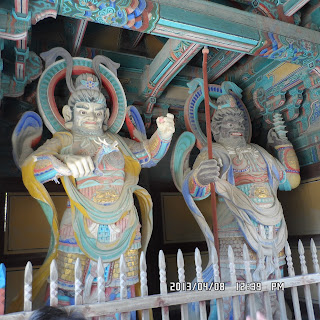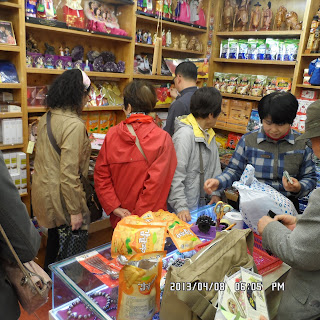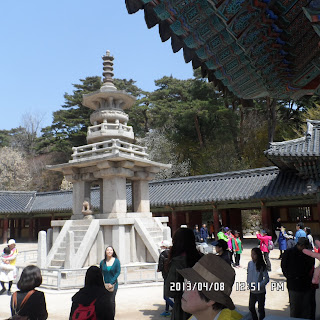Place: Seokguram石窟庵- Bulguksa仏国寺-Cheonmachong天馬塚 -Cheomseongdae瞻星台-Anaji雁鴨池) in Gyeongju, Korea
Sightseeing Course: Toyoko-in Busan#2 Hotel – Seokguram(石窟庵) – Bulguksa(仏国寺) – Cheonmachong(天馬塚) – Cheomseongdae(瞻星台) – Anaji (雁鴨池) – Toyoko-in Haeundae(海雲台) in Busan
Partner: Kikko and her 8 friends (students)
It was the 2nd day for my wife and her 8 friends in Korea. I asked a Korean travel agency named “Hana Tour” to organize a tour in Gyeongju. They dispatched a guide named Daegil Seo (徐大吉).
Daegil in Japanese, “Daikichi” which means “Great Luck” in oriental fortune-telling. So, it is very familiar name in Japan. Everybody remembered his name immediately.
(Actually his name turned out not as it supposed to be at the end of this trip. He got wound by traffic accident.)
He came to our hotel in Busan and took us to the micro-bus which took us to Gyeongju for sightseeing.
The bus driver’s name is Mr. Han, maybe 40s, unfortunately he drove the bus a bit roughly all day. It might be his character or just his driving technique, unknown, though.
The cherry blossom season in Busan was almost over, but as we approached to Gyeongju, we could see many cherry blossoms in full bloom, that made us happy.

[The cherry blossoms and forsythia were in full broom in Gyeongju, 慶州では桜もレンギョウも満開だった。경주에는 벚꽃도 개나리도 만발했다.]
We left the hotel at 8:00 am and arrived at Seokguram Parking Lot at about 11 am.

[The micro-bus at the parking lot at Seokguram, 石窟庵駐車場に到着したマイクロバス、마이크로 버스가 석굴암 주차장에 도착했다.]
It might be too much walk last day, 4 members did not go to Seokguram, because they were tired to walk. So they stayed at the bus, and just had sightseeing around the parking lot. Some old women were selling foods and gits for the sightseers. Some of us bought roast chestnuts which tasted very good.

[Only 6 people dared to walk to Seokguram, わずか六人だけが石窟庵まで歩いた、불과 여섯 명만이 석굴암까지 걸었다]

The six of us, including myself, followed Guide Daegil and walked for about 1 km on way to see the beautiful stone statute in the Seokguram. It is too bad that taking pictures had been prohibited. But one of sightseers in front of me, took the picture with his cellphone. I think it should prohibit only use of flish-light. There is no harm to take pictures of the beautiful statute without flash-lights. Anyway, I followed the rule and did not take a picture.

[Seokguram behind the lines of lanterns, 提灯の飾りの後ろの建物が石窟庵、초롱 장식뒤의 건물이 석굴암]

[The building to protect Seokguram, 石窟庵を保護する建物、석굴암을 보호하는 건물]
Seokguram:
http://en.wikipedia.org/wiki/Seokguram

[The entrance of Seokguram, 石窟庵入口、석굴암 입구]

["No photograph in the room" 「室内撮影禁止」、"실내 촬영 금지"]
Fortunately it was not too crowded that day, so I could see the statute well. I felt only sorry for the 4 members who could not walk this short distance. But my wife commented that it was good thing that they gave up coming to Seokguram, because the steps in front of the building was too steep for them to climb. It was only 20 – 30 cm, though.

[The exit of Seokguram, 石窟庵出口、석굴암 출구]

[The steps out of Seokguram, 石窟庵外部の階段、석굴암 외부 계단]
After seeing Seokguram, the guide took us to Bulguksa Temple. The micro-bus stopped at the parking lot in front of the temple, so all of us followed the guide and visited the temple.

[A group picture in front of Bulguksa, 仏国寺の前で集合写真、불국사 앞에서 단체 사진]
Bulguksa:
http://en.wikipedia.org/wiki/Bulguksa

[Two statutes of Four Guardians, 四天王のうちの二体、사천왕 중 두가지]

[After entering through the gate,山門を通って本殿へ向かう、산문을 통해서 본전으로 향했다.]

[We listened to the guide's explanation, 仏国寺・紫霞門の前で、불국사 · 자하문 앞에서]

[A part of the front building of Bulguksa, 仏国寺前面の建物の一部、불국사 전면 건물의 일부]
I visited this temple in May 1986 with one of my 5 elder sisters, Teruko. Since then, I visited the same temple with different people more than 5 times. But for the first time, one of the two famous Taps [Dabotap(多宝塔) and Seokgatap(釈迦塔)], the Seokgatap was under construction. (They are repairing this national treasure now.)

[A huge box to cover "Seokgatap" under refinement project, 「釈迦塔」は修理中、"석가탑"은 수리중]

[The Main Hall of Bulkuksa, 仏国寺の大雄殿、불국사 대웅전]
There were pictures of 1966 Repair of "Dabotap," and pictures of treasures found then, on the wall of the big container building.

[The picture of 1966 Repair, 1966年の宝塔解体作業の写真、1966 년 보탑 해체 작업 사진]

[The pictures of the treasures found then, 解体時に発見された宝物の写真、해체시 발견 된 보물 사진]
I wish I could visit here again, and I could also visit the museum of this temple where these national treasures and some Buddhism related sculptures which a Japanese sculptor made and contributed to the temple.

[A statute of pig for sightseers, 観光客用に置かれた『金の豚』の像、관광객을 위해 놓인 "황금 돼지"동상]

[After the sightseeing at Bulguksa, 仏国寺の見学を終えて、불국사 관람을 마치고]
After sightseeing at Bulkuksa Temple, the guide took us to the "ssampap" or "rice wrapped in greens" restaurant named “Sambo (森浦.)” This restrant was the same restaurant Kikko and I came two years ago.

["Ssampap" lunch at Sambo Restaurant, 森浦にてサムパプランチ、삼보에서 쌈밥 점심]
They serve many dishes, actually too many that we could not eat them up. When the lunch time was over, Kikko picked up some of the leftovers, such as “miso” or “tsukudani”-like food and gave them to me later. I ate them a little by little and I still have some in my regregirator one month later.
When we went out from the restaurant, the cherry blossoms in front of the restaurant were in full bloom and very beautiful.
The rest of the sightseeing spots were all located around this restaurant in Gyeongju Historic Area.
Gyeongju Historic Area.
http://en.wikipedia.org/wiki/Gyeongju_Historic_Areas

[The entrance of Park of Ancient Burial Mounds,『大陵苑』古墳公園の入り口、"대능원" 입구]
First, we went to Cheonmachong(天馬塚) which is a tomb of an unknown noble similar to Takamatsu-zuka in Japan. These nobles or royal family members lived in 7th or early 8th century in both countries.
This area has been very popular places for domestic as well as foreign sightseers just like Seokguram and Bulguksa Temple.
Silly rule is no photographing. These all exibitions in the tomb are nothing in genuine, but all fake. Yet they prohibit taking pictures. I think it is nonsense. Of course, using flash-light should be prohibited, but without flash light, nothing wrong to take pictures of fake treasures, I thought.
After seeing the inside of the royal tomb, we went to Cheomseongdae:
http://en.wikipedia.org/wiki/Cheomseongdae

[A group picture in front of Cheomseongdae, 瞻星台前で集合写真、첨성대 앞에서 단체 사진]
which is claimed to be the oldest astronomical observatory in orient world by some scientists, but exact year when it was built, and the purpose of the building was not yet known. It was said to be built during Queen Seondeok of Silla (新羅・善徳女王632-647) period.
It was too bad that the cherry blossoms around Cheomseongdae were a bit too late, and rape blossoms were too early to be in full bloom.
Then Guide Daegil took us to Anaji, a beautiful garden with nice old pond. It used to be a royal resort villa during Shilla period. They discovered a lot of thing which noble family members used such as plates and utensils in the pond “Anaji.”

[The main building at "Anaji" Park, 雁鴨池公園の主要な建物、안압지 공원 주요 건물,]
We took a group pictures in the garden and went back to Busan.

[At the Anaji Park, 雁鴨池公園にて、안압지 공원에서]
I visited here several times before, but I still like to visit here and see the pond and these “treasures” (of course, knowing that they are all replicas.)
On the way back to Busan, the guide, Daegil, took us the last sightseeing spot, the preserved traditional house of the Choi Family in Gyeongju.

[At an old house since 1700, 保存された1700年代の伝統家屋にて、보존되어 있는 1700 년대의 전통 한옥에서]

[The explanation about "Family Precepts of the rich Choi Family in Gyeongju, 崔家の家訓の説明、경주 최부자집의 가르침]
Guide Daegil took us to International Market in Busan. My wife and her 8 friends were most exited here than anywhere else. They do like shopping.

[At International Market in Busan, 釜山の国際市場にて、부산 국제 시장에서]


The Guide Daegil took us to the sightseeing shop which he might have business tie-up in Arilang Street. But my guests preferred to another shop in front of the Daegil recommended shop.
They bought a lot of souvenirs for the family members. Among things they bought, I liked the taste of “Nurunji”candy. “Nurungji누룽지” is crust of overcooked rice, and they made candies out of this scorched rice powder. I like the flavor of the candies very much. Then the owner of the shop gave me a bagful of the candies for free. (They thought I was the leader of the group, and expressed their gratitude for bringing so many customers to their shop.) After about an hour of “shopping spree,” when we were going to our hotel in Haeundae, an unlucky accident happened to us, esp. to the guide, Daegil.
Soon after we all aboard on the bus, our driver made a sudden break because a car came in front of the bus. The bus driver stopped the micro-bus too abruptly and everyone on the bus hold something in front of him/her, except my wife and the guide.
Kikko was sitting in the front of the back-most seat, just next to me. There was a backseat to hold in front of me, but nothing in front of her since she was sitting in the center of the back-most seat. So, she fell down to the isle, face to the floor. She could not get up immediately after the sudden stop. But eventually she got up.
In case of the guide, he was not sitting, so he fell down on the floor really hard. He hit his forehead and ribs on the floor of the bus and some other part really hard. He could not get up for a couple of minutes. Everybody worried about him including the driver. But Daegil woke up.
Our bus arrived at Toyoko-in Haeundae at 7:30 pm. The guide reserved a restaurant named “Dalmaji” previously on the phone. So the driver of the restaurant was waiting for us.
After having a quick check-in, we all went to the restaurant which the guide reserved. It must be a high-class restaurant for sightseers, and Daegil must have relationship with them.

[At Dalmaji Restaurant in Haeundae, Busan, 釜山、海雲台の『タルマジ食堂』にて、부산 해운대 "달맞이 식당"에서]

Anyway, Daegil accompanied with us and went to the restaurant together. We ordered “Bulkogi” or Korean barbecue, and had “bibimpap” and “nengmyon” and a few bottles of beer and makgeolli.
The basic charge for the simple barbecue was 20,000 won for each (about 20 dollars) and additional cost was 25,000 won (about 2.5 dollars). It must be reasonable price, but I felt it was very expensive, thinking of the price local people pay.
So I lost my apatite it must be good for everyone, because, I did not eat much and I did not drink much. So did everyone because they are senior citizen (less appetite comparing with young people.)

[With Kikko after the dinner, 夕食後、妻とツーショット、저녁 식사 후 아내와 단 둘이 사진]
We ended the party at around 8:45 pm and went back to the hotel, Toyoko-in Haeunde at 9 pm.

[After the dinner before going to the hotel, 夕食後、ホテルへ行く前に、저녁 식사 후 호텔에 가기 전에]
The guide, Daegil accompanied at the last moment. A member of our group, Ms. Kubota paid him 100,000 won tip (about 100 dollars . Later we shared the cost. I should have considered this cost beforehand. Later I learned that appropriate tip for the guide for each member was 10,000 won. So what Ms. Kubota paid was exactly correct.
I worried about the wound situation of Daegil. So after the trip was over, I visited the travel agent and got his personal address. I heard that he had been hospitalized, so I sent a letter with the same amount of condolence money which Ms. Kubota paid. One week later, I got a call from Daegil that he got my snail-mail letter on the day he left the hospital. (Kikko and all other members were all right. No one had to be hospitalized in Japan after the trip.)
---------------------------------------------------------------------------------------------------------
分類:旅行、韓国、慶州
旅行日:2013年4月8日(月)晴れ
旅行地:韓国、慶南、慶州(石窟庵、仏国寺、天馬塚、瞻星台、雁鴨池、校洞・崔氏古宅)と釜山国際市場アリラン通で買物
観光コース:[ハナツアー] 東横イン釜山駅②8:30→石窟庵(ソックラム석굴암)11:08~仏国寺(ブルグクサ불국사)11:30~森浦サムパプ(삼보쌈밥昼食)13:50~天馬塚(천마총)14:50~慶州パン(饅頭:ショッピング)15:10~瞻星台(チョムソンデ첨성대)15:25~雁鴨池(アナッチ안아지)15:40~校洞・崔氏古宅(16:16)→国際市場アリラン通り(17:36着)みやげ物ショッピング(18:30まで約1時間)→釜山の海雲台ホテル(途中軽い交通事故)←→月見(タルマジ달맞이)レストラン(夕食20:00-20:45)
同行者:喜久子及び彼女の友人8人
喜久子たちの韓国観光二日目で、この日は釜山から慶州日帰り旅行。依頼したハナツアーが派遣したガイドは徐大吉という分かりやすいややメタボリックな男性ガイドで愛嬌がいい。
運転手は韓という40代くらいの男だが、運転が荒い。道路に凹凸があってスピードを緩めないため、みなドキドキハラハラ。
喜久子と三年前に使った乗合ではなく、貸切バスなので融通が利く。
釜山は桜が終わっていたが慶州はまっさかりでどこも見ごろだった。

[The cherry blossoms and forsythia were in full broom in Gyeongju, 慶州では桜もレンギョウも満開だった。경주에는 벚꽃도 개나리도 만발했다.]
さて、今回、慶州で最初に見学する石窟庵と仏国寺はともに1995年に「石窟庵と仏国寺」として世界遺産(文化遺産)に登録されている。
我々は、まず仏国寺の石窟庵へ向かったが、馬上さんをはじめ4人が駐車場から石窟庵までの1kmほどの道を歩くのが辛くてリタイア。駐車場で露天のおばあさんをひやかして、焼き栗などを買って待っていた。焼き栗は安くてとてもうまかった。

[Peddlers at Seokguram Parking Lot, 駐車場の『露天市場』、주차장의 '노천 시장']

[Only 6 people (including me) dared to walk to Seokguram, わずか六人だけが石窟庵まで歩いた、불과 여섯 명만이 석굴암까지 걸었다]

[Seokguram behind the lines of lanterns, 提灯の飾りの後ろの建物が石窟庵、초롱 장식뒤의 건물이 석굴암]
石窟庵:
http://ja.wikipedia.org/wiki/%E7%9F%B3%E7%AA%9F%E5%BA%B5

[The design of Seokguram, 石窟庵石窟図、석굴암 석굴도]
残りの6人はゆっくりと歩くため非常に時間がかかる。しかし石窟庵は意外と空いていて、落ち着いて仏像を見ることができた。

[The steps out of Seokguram, 石窟庵外部の階段、석굴암 외부 계단]
石窟庵を見学するのはこれで3回目だが、今回、気が付いたのは瓦に願い事を書いて奉納する日本の「絵馬」のような慣習だ。
[People can buy a tile and write his/her wish on it and dedicate it to the temple, just like "Ema" in Japan, 以下の写真は石窟庵の寺に奉納された瓦である。奉納した人の訴願が書いてある。다음 사진은 석굴암의 사원에 봉납 된 기와이다. 봉납 한 사람의 소원이 적혀있다.]





流石に世界遺産に登録された観光地だけあって、外国人の観光客も実に多く、鎌倉の寺の絵馬に国際色豊かな願い事が書かれている如く、ここの瓦にも実に多くの国の言葉で願いが書かれていた。
石窟庵を観終わってから我々六人は駐車場で待機していた四人と共に、仏国寺へ行ったが、こちらは全員ガイドの後をついて説明を聞いた。

[A group picture in front of Bulguksa, 仏国寺の前で集合写真、불국사 앞에서 단체 사진]
仏国寺は1986年5月、今から27年前に私の五人の姉のうち2番目の姉と韓国を訪れた時初めて訪ねて以来、テジョンハイカーズの友人や、一昨年は妻とも訪ねたりして今回は5回目になろうかという場所だ。
仏国寺:
http://ja.wikipedia.org/wiki/%E4%BB%8F%E5%9B%BD%E5%AF%BA#.E5.AE.9D.E5.A1.94
ウィキペディア(WK)によると仏国寺は新羅景徳王の時代の751年に、宰相だった金大城(キムデソン)により建立が始まったというから、奈良時代の建立である。完成したのは774年 新羅(恵恭王10年)というから工事は23年かかっている。

[Two statutes of Four Guardians, 四天王のうちの二体、사천왕 중 두가지]
最盛期の8世紀は、約60棟の木造建築で寺院は構成されていたが、李氏朝鮮の太宗による1407年(太宗7年)の仏教弾圧の際、存続を許された88寺院の中に名前がなく、廃寺になったとWKは記述している。
世宗による1424年(世宗6年)の仏教弾圧の際、存続を許された36寺院の中に名前がなく、引き続き廃寺のままだったようであるが、さらに1593年、文禄の役の戦乱により、仏像・石棺・宝塔以外が焼失したとされ、この説明を聞くと日本人の良心が痛む。
江戸時代初期の1604年より再建が始まったが、日本の朝鮮統治時代(1910-1945)までに荒廃した。
1973年に発掘調査後、改修工事で無説殿、観音殿などが再建された。
2010年に日本の仏師の福井照明が製作した四天王像など12体の仏像が寄贈され、仏国寺・聖宝博物館に常設展示されたと聞くと日本人としては良心の呵責が少し和らぐが、このことの説明は大吉ガイドも以前のガイドもない。仏国寺・聖宝博物館を訪れればあるだろう。

[We listened to the guide's explanation, 仏国寺・紫霞門の前で、불국사 · 자하문 앞에서]
さて、仏国寺の数々の宝物のうち、紫霞門と大雄殿の間に釈迦塔と多宝塔という2つの三重の石塔があるが、このうちの釈迦塔が今回は修理中で見ることができなかった。

["Dabotap" at Bulguksa, 仏国寺の『多宝塔』、불국사 "다보탑"]

[A group picture in front of Main Hall, 大雄殿の前で集合写真、대웅전 앞에서 단체 사진]
しかし、立派な入れ物ができていて、1966年の修理当時の写真や、釈迦塔から発見されたという宝物の写真が展示されていた。今回の修理にもかなりの年月を要するようだが、次回訪問する時は完成しているかもしれない。

さて、仏国寺の後、大吉ガイドが焼き物の展示されているところへ案内しましょうかと言ったが、すでに1時を過ぎていて、こちらはあきらめ、サムパプの店へ直行した。 ここは前回と同じ場所で、家の中が個人の博物館のようになっている「森浦(삼보)」というレストランだった。

["Ssampap" lunch at Sambo Restaurant, 森浦にてサムパプランチ、삼보에서 쌈밥 점심]
前よりも品数が減ったのではないかと思われたが、それでもまあまあみな満足のようだった。実際、食べきれなかったおかずのうち、もちの良さそうな味噌や佃煮のようなものは喜久子が空き容器に入れ、後で私にくれた。私は少しずつ食べて、1ヶ月後の今でも佃煮風の食品の残りが私の冷蔵庫に入っている(保存食品であり味は変わっていない。)
昼食後はみな近所の観光地で、まず天馬塚に入ったが小学生の修学旅行か、やたら混んでいてなかなかじっくり観察できない。もっとも私は5回以上ここを見学している。また、展示品はレプリカばかりなのに撮影禁止とは納得いかない。フラッシュ禁止で撮影自由にすべきだ。

[Kikko in front of Cheonmachong, 天馬塚の前の喜久子、천마총의 앞에서 키쿠코]
天馬塚の後は瞻星台(첨성대)へ向かった。
さて、瞻星台(せんせいだい)は、韓国 慶尚北道慶州市にある建造物で韓国の国宝(国宝第31号)。韓国では東洋最古の天文台と主張されている瞻星台で、この周辺の桜はやや盛りを過ぎた感じ。また、一面の菜の花はやや早すぎる感じで、私の率いるグループはその近くまで歩く元気はない。

[A group picture in front of Cheomseongdae, 瞻星台前で集合写真、첨성대 앞에서 단체 사진]
瞻星台を見学してから次のポイントの雁鴨池(안아지)へ向かった。雁鴨池は慶州でも私の好きな場所の一つで、埋もれていた新羅の王族の別邸を再現し、池から出た遺物(レプリカ)を展示している。

["Anaji" Pond, a garden for the family of "Silla Kingdom", 雁鴨池(新羅時代の王宮別邸)、안아지(신라 시대의 왕궁 별장)]
喜久子はこのは2度目で見学には興味がないようで、再建された別邸まで行かず、通路に座って休んでいたのは残念だ。観光を楽しむにはまず体力、そして旺盛な好奇心が必要だ。「好奇心(興味)」と「物理的条件(体力保存)」を天秤にかけると、後者の方が勝ったのだろう。

[At the Anaji Park, 雁鴨池公園にて、안압지 공원에서]
一昨年のツアーでは、雁鴨池の後、伝統酒「法酒」の製造元へ連れて行かれ、私だけがそこで「法酒」を購入したが、大吉ガイドは酒造元へは案内せず、そのすぐ隣の校洞・崔氏古宅へ案内してくれた。

[At an old house since 1700, 保存された1700年代の伝統家屋にて、보존되어 있는 1700 년대의 전통 한옥에서]

[The family precepts of the Choi Family in Gyeongju, 崔家の家訓、최부자집의 가르침]
ここは新羅時代(紀元356年- 935年)よりずっとくだった李朝朝鮮時代の1700年ごろに建てられた地方豪族の家を保存して展示しているもののようだ。
その後、慶州観光を終え、釜山へ戻る途中、往路とは別に、普門観光団地を通った。皆は、慶州へ来る道路の桜が見事だったのでこちらを通ろうと主張したが、帰路の桜がさらに見事だった。しかし、一度もバスを停めなかったのは悔いが残る。10分間でも停めて写真撮影できればよかったと思う。
釜山へ戻ってからは、国際市場のアリラン通りでショッピングした。喜久子とその一行は、天馬塚や瞻星台や雁鴨池よりこちらのほうが活気づいた。

[At International Market in Busan, 釜山の国際市場にて、부산 국제 시장에서]

大吉ガイドは彼がタイアップしている店に連れて行ったが、馬上さんがキムチを買おうとするとそこの女店員がさらにたくさん買わせようと流暢な日本語で勧めた。しかし、非常にアグレッシブな感じがして我々は腰を引かざるを得ない。
むしろその前の店の店主夫婦が大人しくて控えめで感じが良かったので、みなこちらで買い物をした。今回初めてヌルンジ・キャンデーを食べてみたがうまかった。私も無料で1袋いただいた。
ヌルンジとは「おこげご飯」のことで、伝統的なレストランでは食事の時、スチール製の器にこの「おこげご飯」にお湯を注詩だものが出てくる。香ばしくて懐かしい味がする。
さて買い物の後、ホテルに戻ろうとしたが、バスが発車してすぐ、バスの前に他の車が飛び出したため、運転手が急ブレーキを踏んだ。この時、皆はシートベルトをしておらず、最後列の前に座席のない席に座っていた、喜久子と、説明のため立ち腰だった大吉ガイドがつんのめった。
喜久子も通路にうつぶせにつんのめったので心配したが大事にはいたらなかった。しかし、大吉ガイドが額とあばら骨を打ってしばらく立ち上がれなかった。
喜久子は事故証明のやり方を保険会社に電話して聞き、大吉ガイドから一筆とった。大吉ガイドにもホテルに着いてから私が1筆与えた。
ホテルへチェックイン後、大吉がすすめるタルマジ・レストランの迎えの車が我々をレストランに連れて行ってくれたが、料金が高いと感じた。

[At Dalmaji Restaurant in Haeundae, Busan, 釜山、海雲台の『タルマジ食堂』にて、부산 해운대 "달맞이 식당"에서]
基本料金20万ウォンでは焼肉は1種類だけ。あとは冷麺3つと石焼ビビンパ1つを追加注文して、皆で分けて食べた。それでも美保子さんが注文した石焼ビビンパは非常に味が良く、窪田さんも追加注文した。

[At Dalmaji Restaurant in Haeundae, Busan, 釜山、海雲台の『タルマジ食堂』にて、부산 해운대 "달맞이 식당"에서]
1本4000ウォンのビール2本と6000ウォンのマッコリ1杯を加えて会計は25万1000ウォンだった。私はあまりに高くで食欲を失ったが、一人当たり2.5万ウォンは日本円で2000円強だからこれは相場なのかも知れない。

[With Kikko after the dinner, 夕食後、妻とツーショット、저녁 식사 후 아내와 단 둘이 사진]
さて、事故の後、大吉ガイドは相当痛いようだったが我慢して最後まで付き合った。別れるとき、窪田さんが10万ウォン、チップをあげた。あとで全員から一人1万ウォンずつ集めた。ホテルに戻ったのは9時過ぎだった。
反省:ガイドへのチップはあらかじめ計算に入れておくべきで、一人1万ウォンが相場。私は後に大吉ガイドが入院したことを聞き、見舞いの手紙と共に見舞金10万ウォンを彼の住所へ送った。大吉ガイドから退院したという知らせと共に手紙が届いたという電話が来た。
0 件のコメント:
コメントを投稿